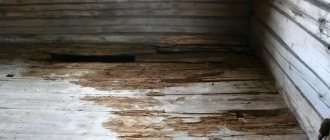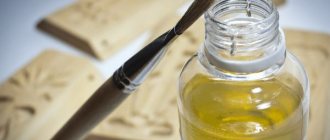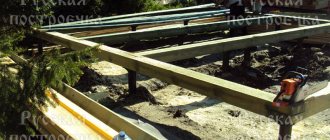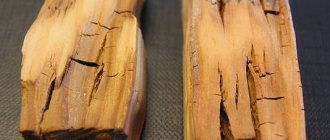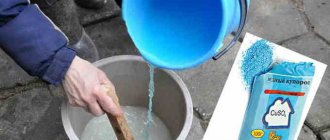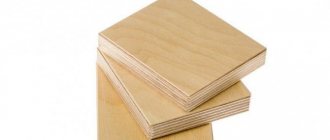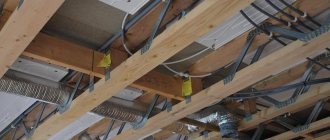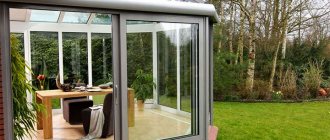If a residential or non-residential building has wooden floors, then it would be wrong to leave them without a protective finishing coating. Without it, the surface will quickly become dirty, worn out, covered with mold or damaged by microorganisms. Wooden floors are processed using different materials. They not only protect the surface and extend its service life, but also improve aesthetic performance, giving a matte or glossy shine, a certain color or shade, emphasizing the beauty of the wood texture. To understand how to treat a wooden floor, you need to take into account the purpose of the room, the temperature and humidity conditions in it, and the properties of the coating.
Features of log operation
Wooden structural elements during operation are not directly exposed to all kinds of natural factors, such as precipitation and wind. As a rule, there is no direct contact between the logs and the natural environment.
Sometimes dampness can damage them only if they are laid on a damp foundation. But when installing logs, property owners strive to prevent the beams from coming into contact with the external environment. In this case we are talking about the device of vapor and waterproofing.
Since wood is highly susceptible to rotting processes and mold fungi can intensively multiply on it, it must be protected from adverse external factors.
Even with slight non-compliance with the technology for installing wooden beams, the wood begins to rot. It is for this reason that floor joists need to be treated with various special compounds that can protect structural elements from unfavorable processes. This procedure is considered mandatory and should not be forgotten when arranging a wooden floor.
General Tips
Beams are supporting elements for the construction of a floor or ceiling; they must withstand maximum design loads and have a safety margin. Depending on the purpose and operating conditions of the premises, the thickness of the beams and the distance between them are selected. The materials can be used beams with dimensions of 50×50 mm or more or boards with parameters from 50×150 mm. On lumber with smooth surfaces, the subfloor can be attached from the bottom, side or top; on round beams - only from the bottom or top.
Characteristics of wood used for floor joists
Table. What elements does a classic subfloor consist of?
| Item name | Purpose and description |
| Beams or joists | The main load-bearing element absorbs all static and dynamic forces. In each individual case, individual calculations are made based on linear parameters and distance steps. They can rest on columns, foundation strip, floor slab, facade walls or load-bearing interior partitions. |
| Skull bars | Size - approximately 20x30 mm, fixed to the side surfaces of the beams, used for laying subfloor boards. |
| Hydro- or vapor barrier | The waterproofing is laid on the subfloor, which serves as the foundation for the finishing floor. Vapor barrier is used to protect insulation from increased relative humidity; it is used on the first floors or ceilings. |
Depending on the specific placement and purpose of the subfloors, the listed elements may be added or excluded. We'll look at a few of the most commonly used types of subfloors.
Floor beams
Types of structures made of natural wood
Since any type of tree is a material that can easily rot, the question remains relevant: “How to treat floor joists?”
As mentioned above, moisture does not get under the flooring from the external environment, but it is present there. This means that condensation is accumulating under the floor surface. The reason for this phenomenon lies in the difference in air temperatures between the room and the basement below it. However, the difference between them can be significant.
All this means that treating wooden joists is really necessary. In addition to rotting, wood is a favorable breeding ground for various insects that can completely destroy the wooden floors of a building. This should not be allowed. Pests need to be destroyed.
There is no perfect solution for how to treat underfloor joists. The choice largely depends on the type of wood that was used to install the floor structure. The water environment can affect each wood species differently. The fact is that the microclimate in the floors of each of the constructed houses has its own characteristics, and they depend on many parameters.
Where houses are built, the climatic conditions, as well as the soil and air humidity, differ. Solving the problem of how to impregnate the logs should be approached responsibly.
What types of impregnations can there be?
The construction market boasts a huge range of impregnations. They differ in protective properties, chemical composition and base. They may have the following protection methods.
Antiseptic
Prevents the appearance of rot, fungus and mold. This type of solution is the most toxic, and when working with it, care must be taken, using protective equipment and ensuring sufficient ventilation in the room.
The most commonly used for this purpose are clay, silicate and bitumen compositions. Some antiseptics can be made independently from low-toxic liquids available in the house, for example, oils and their products.
The use of such “homemade” impregnations on new, pest-free floors gives a long-term positive effect and allows you to protect people and pets from the effects of toxic substances.
Fire retardant
Reduces the wood's ability to ignite. Such impregnation usually contains various phosphates or boric acid. When the temperature rises significantly, a film forms on boards treated with such chemicals, preventing them from igniting.
Water repellent
Wood has strong moisture-absorbing properties. Getting on its porous surface, water causes swelling and creates favorable conditions for the appearance of fungus and rot. This is especially true for the floor in the kitchen or bathhouse. Using impregnation will help you avoid such troubles, because by filling the wood pores with its composition, it creates a moisture-repellent layer.
Combined
Presented with a combination of antiseptic + water repellent. Sometimes flame retardant components are added.
As a rule, when performing protective treatment on a wooden floor, combined compounds are used.
They may differ based on:
- Soil protection. Such impregnations combine the qualities of primer mixtures and the necessary protective properties. After their application, in compliance with all priming rules, the final application of the decorative layer is carried out on the floor surface.
- Impregnating solutions that require subsequent priming and painting with paints and varnishes after drying.
According to the chemical composition, such a primer can be:
- Epoxy. More often it is a primer-impregnating mixture based on epoxy resins and with the addition of various components that have antiseptic properties. It creates a durable water-repellent film on the surface of the board. Epoxy compounds have excellent protective properties. They are best used in damp areas, in the kitchen, bath or bathroom.
- Alkyd impregnating mixture is considered one of the best. Ideal for damp areas in the home, low toxicity, can be produced on a primer basis or as a pre-treatment solution before priming. Using it in a kitchen or bath will reliably protect the flooring from dampness and mold. The downside is that it takes a long time to dry. The drying process takes about 18 hours.
- Shellac - based on methyl alcohol and the milky juice of insects. It is used when it is not possible to ensure high-quality drying of the floor; it has high protective properties. After applying it and before subsequent priming, you must wait until methyl alcohol penetrates the wood structure and displaces water.
- Acrylic is the easiest to use. As a rule, this impregnating soil mixture is made on a water-dispersion basis, easily fills the pores of wood, dries quickly and reliably protects against rot.
Treatment of floor structures from rotting
Without taking measures to prevent rotting of any structures made of wooden elements, including floors, any structure will require major repairs as soon as possible. The domestic market offers a wide selection of effective means to treat logs against rotting.
According to both specialists and home craftsmen, a product called “Senezh” has proven itself best, but, unfortunately, it cannot be called universal. When purchasing it, you should pay attention that an individual composition has been developed for each tree species. The cost of the product depends on it. This antiseptic contains approximately 10 different drugs. In addition, the way they are used is also different.
It was for lags that the drug “Senezh Ognebio” was created, which:
- perfectly protects wood;
- applies effortlessly;
- has an affordable price;
- able to prevent fire in a wooden house;
- is an excellent biological protection of bars.
This product, shown in the photo, can be used to treat all areas of wooden joists without exception. "Senezh Ognebio" is also used for impregnation of log structures.
Once applied to wooden elements, the preparation protects against fire for a period of up to 3 years. When a professional antiseptic is used for floor joists, this period increases to 5 years. If we talk about bioprotection, the period of effective action is about two decades.
When applying Senezh Ognebio, you should remember that it is unacceptable for the logs to have previously been treated with other paints or film materials. Use this product according to the instructions on the package. When the composition is applied to the bars, their original shade changes to reddish.
Preparatory work
To get a beautiful and even coating, you need to go through all the necessary steps and strictly adhere to the application technology. Oil impregnation is absorbed very well into wood, so all the imperfections and defects of the floor will immediately appear under the oil. The surface that is supposed to be impregnated with oil requires more thorough preparation than when varnishing.
Preparing the old floor
Preparation is necessary for both new and old floors, but in the latter case the preparatory work is complicated by the fact that the previous paint coating must be completely removed. This is usually done using a sanding machine, but if you don’t have a sanding machine, you can use improvised means.
- You can use this method: put a sheet of paper on the floor and place a hot iron on it. When exposed to high temperatures, the paint will come off the surface and stick to the paper. The remaining coating is removed with a spatula. You can use special washes, which are available in a wide variety in stores.
- After removing the paint, you need to remove the top layer from the boards using a plane.
- Next, sanding is done with fine-grit sandpaper (150-180).
- All cracks and other defects must be repaired with putty to match the color of the wood.
Preparing the new floor
- Preparatory work for a new floor consists of sanding the surface. This work must be done very carefully, since any defects in the flooring will be visible under the oil.
- Three types of sanding attachments are used for sanding. First, the work is carried out using circles with coarse grain (20), then the base is leveled with a medium-grain nozzle (40). At this stage, you need to putty all the defects, and then perform final polishing with the finest abrasive (150).
- After sanding, the entire floor surface must be thoroughly cleaned of dust using a construction vacuum cleaner. Poor cleaning can also negatively affect the quality of the coating.
All work must be done not manually, but with the help of sanders, and for processing use special pads made of microfiber and felt. The quality of hand grinding is much lower than machine grinding; it is impossible to bring the surface to an ideal state by hand.
An additional way to protect wood from rot
In practice, another option is used for treating lag from the rotting process - it consists of using creosote. It is customary to treat railway sleepers with this composition. Unfortunately, when applying creosote there is also an unpleasant odor that is difficult to get rid of. It will also not be entirely pleasant to be in such a house.
On the domestic market, the choice of antiseptics for wooden elements is not limited to Senezh. You can treat logs using various high-quality products (read: “How to treat logs in a bathhouse and how to do it correctly”).
When choosing an antiseptic composition, you must not forget that materials from different types of trees have distinctive properties and the drug should be purchased taking into account the characteristics of wooden structures for flooring.
Conclusion
In the video presented in this article you will find additional information on this topic. Also, based on the text presented above, we can conclude that there are quite a large number of different materials intended for impregnation of wood floors. Moreover, they all have their own unique properties, which must be selected taking into account the area of application.
If you need to buy a hovercraft inexpensively with organized delivery, call the phone numbers listed on the website, or write in the feedback form! Polite managers will tell you what the SVP tile leveling system is and how it can help you! In general, we will be glad to cooperate! See you in touch!
Protecting joists from insect damage
Often, owners of wooden houses are faced with a big problem - insect pests that settle in wood cause them a lot of trouble. This phenomenon must definitely be combated. Since the place where the logs are located is always warm, insects prefer to settle and breed there. Entire colonies of pests can render floors unusable and require major repairs.
To prevent this, it is necessary to treat the logs using special protective agents. As practice has shown, the most effective and proven method is the use of resin. It still needs to be prepared for application before use.
The resin is heated by placing it in a metal container. After it softens, you can begin to work. Impregnation for floor joists is applied using a paint brush. After completing this procedure, no pest can penetrate the wood structure. The fact is that such a durable layer almost does not collapse over time.
But not only resin can protect a tree from insects; consumers on the market today are also offered chemicals that allow them to fight pests.
Rules for applying protective compounds
Even the best antiseptic or fire retardant applied carelessly will not produce the desired effect. In order for the protective properties guaranteed on the label by the manufacturer to be fully manifested, you must adhere to the rules for applying impregnations. Follow the diagram:
Stage #1 - drying the wood
The best protection effect is achieved when applying impregnation to wood whose humidity does not exceed 20%. The drier the wood, the more protective agent it can absorb. And, conversely, wet wood will not allow impregnation into its pores, and the protective layer will be of poor quality. A similar effect will be especially noticeable when using impregnations based on organic solvents and oils.
To achieve the required humidity, the wood is dried in a shady, dry place. Best of all - under a canopy in the yard.
Stage #2 - surface cleaning
The wooden surface ready for impregnation must be clean, uniform, without traces of early staining. Contaminated areas lead to a deterioration in the absorbency of the protective composition and to an uneven, spotty color (if there is a color scheme).
If the surface has already been painted, remove the paint or varnish using a hair dryer. The remaining coating is removed with a scraper and a stiff brush. All oil and grease stains are washed off with white spirit.
Go over the cleaned wood with sandpaper or a sander, and blow off the dust with a vacuum cleaner.
Material safety
When choosing impregnation for lags, you need to take into account that at home it is permissible to use only safe compounds. Thanks to this, the wood will be protected from insects, and the health of the people living in the house will not suffer. When purchasing a chemical, you should familiarize yourself with the components included in its composition.
Based on the above information, it is clear that today there are several options available for processing natural wood logs. All of them help solve problems associated with insects - pests and microorganisms that cause decay processes. Both of these activities must be carried out without fail. If such requirements are neglected, then over the next 5 years the floor will become unusable, and repairs will require significant financial costs.
Useful video
Yes, it was surprisingly difficult to find a sane video. We stopped at this video because in it you will find references to compounds that were not found in our text - from the company TEKNOS. She is famous, she has facilities in Russia. Why not?
***
Finally, we would like to invite all of you to be more demanding customers, ask for the composition of the chemicals you are going to purchase and the certificates for it. Your health depends on this, so I would like to see real information, and not streamlined formulations.
